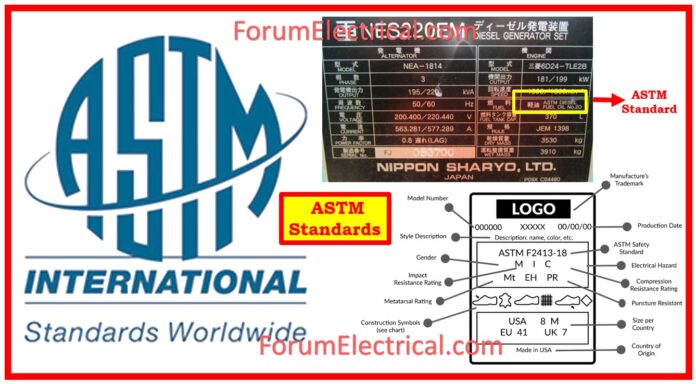What is ASTM?
ASTM – American Society of Testing and Materials
American Society for Testing and Materials (ASTM) which is also called ASTM International is a standards organization that is responsible for developing and publishing technical international standards for a wide variety of materials, products, systems, and services. These standards are developed through voluntary consensus.
Committees of relevant industry professionals meet on a regular basis in an open and transparent manner to create standards, test methods, specifications, guides, & practices.
In the field of wire and cable, the American Society of Testing and Materials (ASTM) is responsible for preparing and publishing standards for a wide variety of materials.
One example that is particularly noteworthy is for conductors.
The International Conductors Association (ICEA) makes reference to these documents in their Standards of conductors are included in the scope of ASTM.
What is the Purpose of ASTM?
Establishing worldwide standards will assure industry reliability and quality.
These standards boost consumer confidence by maintaining consistency & compliance at all stages, from design to production.
It promotes collaboration by developing a language for organizations operating in many industries.
Objective assessments are conducted during the standard-setting process, with the assistance of diverse experts, with the goal of identifying best practices.
This allows for effective quality control & process improvement throughout the sector.
Materials can go through rigorous testing procedures outlined by ASTM standards to ensure their compatibility for the intended use.
Its objective is to forecast not only the existing condition, but also future developments, and to lead industries accordingly.
It supports innovation by establishing guidelines for adapting to rapidly changing technology. This makes products more reliable for companies as well as consumers.
What is the difference between ISO and ASTM?
Certification to the International Organization for Standardization (ISO) is generally considered to be an indication of quality and credibility. At the same time, ISO certification can provide enterprises with a competitive edge and a differentiation in the global market. ASTM, on the other end, does not typically necessitate formal certification.
ASTM Standard Tabulation
| Standard | Description |
|---|---|
| ASTM 10.01 | Electrical Insulation (I): D69–D2484 – ASTMs 10.01 and 10.02 include standards covering: Ceramics, composites, textiles, tape, tubing, plates, rods, insulation, magnetic wire, paper, and cable insulation, and more. |
| ASTM 10.02 | Electrical Insulation (II): D2519–Latest |
| ASTM 10.03 | Electrical Insulating Liquids and Gases; Electrical Protective Equipment – Guides, practices, specifications on electrical insulating liquids and gases, as well as chemical, physical, analytical, and electrical test methods. |
| ASTM 10.04 | Electronics; Declarable Substances in Materials; 3D Imaging Systems; Additive Manufacturing Technologies – Covers standards on inner layer interconnections and bonding, vacuum tubes, hermetic seals, hybrid circuits and substrates, microelectronic packaging, leak testing, and more. |
| ASTM D257:1999 | Standard test methods for dc resistance or conductance of insulating materials |
| ASTM D991:1989 (R2000) | Standard test method for rubber properties-Volume resistivity of electrically conductive and antistatic products. |
| ASTM D2679:1978 | Standard test method for electrostatic charge. |
| ASTM B-49 | Standard Specification for Copper Rod for Electrical Purposes |
| ASTM B-233 | Standard Specification for Aluminium Rod for Electrical Purposes |
| ASTM D4470-97(2004) | Standard Test Method for Static Electrification |
| ASTM F43-99 | Resistivity of a semiconductor material |
| ASTM E1606-20 | Standard Practice for Electromagnetic (Eddy Current) Examination of Copper and Aluminium Redraw Rod for Electrical Purposes |
| ASTM – D2655 | Standard Specification For Crosslinked Polyethylene Insulation For Wire and Cable Rated 0 To 2000V |
| ASTM D 877-02 | Standard Test Method for Dielectric Breakdown Voltage of Insulating Liquids Using Disk Electrodes |
| ASTM D229 – 09B | Standard Test Methods for Rigid Sheet and Plate Materials Used for Electrical Insulation |
| ASTM B 263 | Standard Test Method for Determination of Cross-Sectional Area of Stranded Conductors |
| ASTM D120 | Standard Specification for Rubber Insulating Gloves |
| ASTM B3-95 | Standard Specification for Soft or Annealed Copper Wire |
| ASTM B3-95 | Standard Specification for Soft or Annealed Copper Wire |
| ASTM 2016 B415 – 16 | Standard Specification for Hard-Drawn Aluminium-Clad Steel Wire |
| ASTM B189 | Standard Specification for Lead-Coated and Lead-Alloy-Coated Soft Copper Wire for Electrical Purposes |
| ASTM D229-01 | Standard Test Methods for Rigid Sheet and Plate Materials Used for Electrical Insulation |
| ASTM D3487-09 | Standard Specification for Mineral Insulating Oil Used in Electrical Apparatus |
| ASTM D-374 | Standard Test Methods for Thickness of Solid Electrical Insulation |
| ASTM D924-08 | Standard Test Method for Dissipation Factor (or Power Factor) and Relative Permittivity (Dielectric Constant) of Electrical Insulating Liquids |
Click Here for Indian Standards (Electrical Design)
Click Here for IEC Standards
Click Here for Australia (AS) / New Zealand (NZS) Standards









